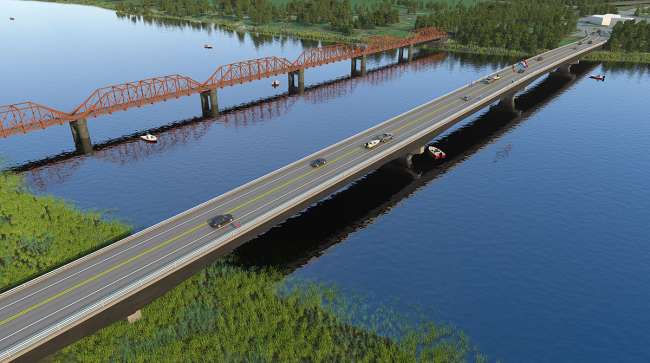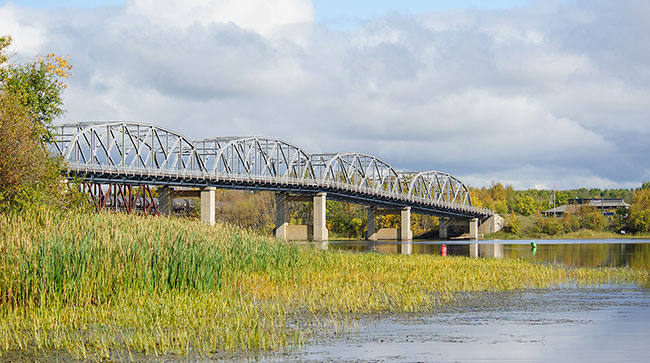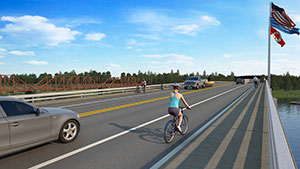Staff Reporter
Minnesota DOT Completes International Bridge Replacement

[Stay on top of transportation news: Get TTNews in your inbox.]
The Minnesota Department of Transportation has completed the $39.3 million replacement of the Baudette/Rainy River International Bridge, which links north-central Minnesota to Ontario.
The bridge, which crosses the Rainy River, connects state Route 72 and Ontario Highway 11. Restrictions on cross-border travel remain in place due to the coronavirus pandemic. However, people providing essential services, including truck drivers who regularly cross the border to keep goods flowing, are exempt from quarantine requirements.
MnDOT announced construction, which began in 2018, had wrapped up Oct. 13. The project is meant to serve as a safer and longer-lasting bridge, as well as an appropriate crossing facility for pedestrians and bicyclists.

The existing Baudette/Rainy River International Bridge. (Minnesota Department of Transportation)
“It is the only border crossing for 50 miles in either direction,” said Joe McKinnon, project manager for MnDOT. “This portion of the Rainy River is approximately 1,200 feet wide. It is also a popular fishing spot year-round. Construction has been limited during sturgeon spawning times, and provisions were made during construction to allow for fishing boat traffic safety.”
The bridge has one lane of traffic in each direction and a sidewalk on one side.
The project represents a partnership between MnDOT and the Ministry of Transportation of Ontario, and is maintained by both agencies.
“The design of the new bridge has enhanced safety, is of more durable construction and requires minimal long-term maintenance,” said Natasha Tremblay, spokeswoman for the Minister of Transportation’s office. “The bridge can accommodate commercial vehicles and can support full highway traffic loading, including pedestrians and cyclists.”
Stantec, an engineering and architecture firm headquartered in Edmonton, Alberta, created the preliminary and environmental designs. Parsons Transportation Group, based in Washington, developed the final design for the bridge. Some 90 stakeholders were involved in addressing environmental, construction, border and historical concerns.

Visualization of the bridge as an appropriate crossing facility for pedestrians and bicyclists. (Minnesota Department of Transportation)
“The design is a typical steel-girder and cast-in-place concrete deck,” McKinnon said. “The reinforcing steel in the deck is stainless steel as an effort to create a longer life span of the deck surface, before a deck rehabilitation project would need to be done in the future.”
The new bridge replaces a steel truss bridge that was built in 1959. According to MnDOT, the old bridge is a rare example of a Pennsylvania truss structure (named after the Pennsylvania Railroad). Its historic nature made it eligible in the U.S. for listing in the National Register of Historic Places. The state is required by law to inform a responsible government of its availability for preservation and relocation in a process known as “putting it up for sale,” according to MnDOT. However, the U.S. owns only half of the bridge, and Canadian officials did not consider the bridge historic.
“Because of its historic designation, we had to try and offer the bridge for sale,” McKinnon said. “But since ownership of the bridge is split with Canada, we were actually advertising only half of a bridge for sale. The advertising for the chance to buy half of a bridge created a stir online and in the media, but it didn’t generate any interested parties due to the considerable costs to disassemble, move and reassemble.”
Demolition of the old bridge is scheduled to begin in October. The process is expected to take three or four months. Removal of the old bridge structures will continue into summer 2021.
MnDOT plans to host a virtual celebration commemorating the completion of the bridge replacement Oct. 28. An in-person ribbon-cutting ceremony is tentatively scheduled for fall 2021.
Want more news? Listen to today's daily briefing:
Subscribe: Apple Podcasts | Spotify | Amazon Alexa | Google Assistant | More




